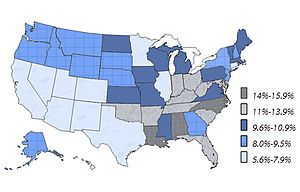
PCBs are industrial chemicals that are still prevalent in our modern world even though they were largely banned in 1977.
From schools to killer whales, these unavoidable toxic PCBs may be responsible for the attention and hyperactivity problems experienced by millions of children today.
According to the Wisconsin Department of Health Services:
Polychlorinated biphenyls (PCBs) are a group of manufactured organic chemicals that contain 209 individual chlorinated chemicals (known as congeners)…
PCBs don’t burn easily and are good insulating material. They have been used widely as coolants and lubricants in transformers, capacitors, and other electrical equipment. The manufacture of PCBs stopped in the United States in 1977 because of evidence that they build up in the environment and cause harmful health effects. Products containing PCBs are old fluorescent lighting fixtures, electrical appliances containing PCB capacitors, old microscope oil, and hydraulic fluids.
During the time that PCBs were manufactured, there were often no effective controls on disposal. Because they do not break down easily, PCBs are now found widely distributed in our environment. Generally their concentrations in the environment are quite low. However, the chemical properties of PCBs cause them to be concentrate up the food chain.
It is not only prenatal and infant exposure to PCBs that can cause a whole host of problems for developing children.
Neurological problems have been found in children whose mother’s ate “moderate to high amounts of contaminated fish during the six years preceding the pregnancy”.
In addition to lower birth weight, cognitive problems, and immune system suppression, a new study has found PCBs could be responsible for attention and hyperactivity problems in children.
Nation of Change reports:
Now new research conducted in New Bedford suggests that these industrial chemicals, which were first linked to learning problems in children more than two decades ago, may play a role in attention-deficit hyperactivity disorder (ADHD), too.
Boys who were exposed to higher levels of PCBs in the womb scored lower on focus and concentration tests, which indicates that they are more likely to have attention problems often related to ADHD, according to a newly published study of New Bedford area children.
All of the children studied were born to mothers who lived near the contaminated harbor and dumpsites in these low-income communities, where twice as many people live below the poverty line than the Massachusetts average. But experts say that their exposure levels were fairly low, comparable to people’s levels throughout much of the United States, which means that a connection between PCBs and attention problems in boys could exist in other communities, too.
Banned in the United States more than 30 years ago, PCBs are long-lived industrial chemicals that accumulate in food chains. Nearly every U.S. resident still has detectable levels in his or her blood. PCBs have the ability to disrupt hormones, which can alter how the brain develops.
Nearly every U.S. resident still has detectable levels of PCBs in his or her blood!
Walk into any classroom in American, and you can witness the attention problem difficulties of children and the teachers that try to cope with them. Adults often joke about their own ADD or ADHD, but it is not funny that chemicals banned so long ago our still causing harm to our children.
[…] recent study has found a link between PCBs and ADHD: Boys who were exposed to higher levels of PCBs in the womb scored lower on focus and concentration […]